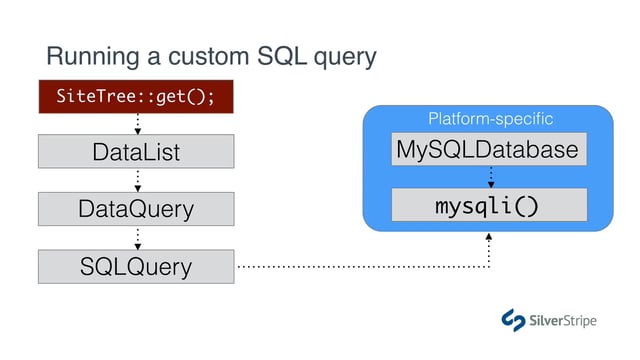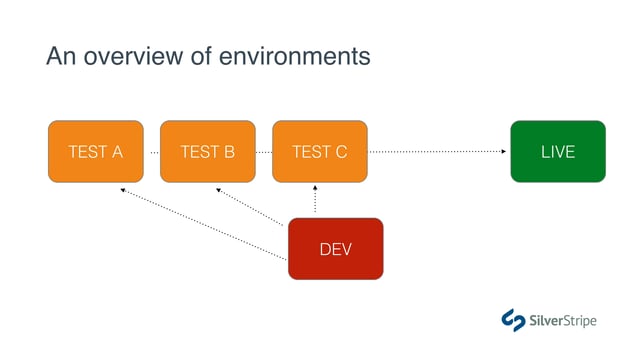In this lesson we'll talk about filtering a list of items on a template. In a previous tutorial, we looked at filtering through form inputs. Now, we'll explore how to do that through the navigation.
What we'll cover
- Setting up new relationships
- Adding lists of filter links
- Setting up the filtered routes
- Adding filtered link methods to DataObjects
- Filtering through controller actions
- Adding filter headers
Having a rich supply of data to work with is paramount to getting value out of this lesson, so once you get the code changes in place, it's a good idea to import the database.sql file that is included in the completed version of this lesson. It will provide you with a hundred or so randomly composed ArticlePage records that we'll be filtering.
Setting up new relationships
Looking at our Travel Guides page, we see that there are a number of different filters we can apply in the sidebar. We have a list of categories, an archive of previous months and years, as well as tags. We won't be using tags for these articles, so let's remove that. We'll be replacing it with a filter for regions, because, optionally, each of these travel guides can pertain to a region.
Before we add the filter, let's set up that relationship. We'll add a has_one to Region on ArticlePage and a has_many from Region back to ArticlePage.
app/src/ArticlePage.php
//...
private static $has_one = [
'Photo' => Image::class,
'Brochure' => File::class,
'Region' => Region::class,
];
//...
public function getCMSFields()
{
//...
$fields->addFieldToTab('Root.Main', DropdownField::create(
'RegionID',
'Region',
Region::get()->map('ID','Title')
)->setEmptyString('-- None --'), 'Content');
return $fields;
}app/src/Region.php
//...
private static $has_many = [
'Articles' => ArticlePage::class,
];
//...Run a dev/build?flush. If you've already done the database import, there should be no changes to the database, but it's still critical to update the model.
Adding lists of filter links
Now we can get into the meat of the lesson and start creating some filters.Let's look at our ArticleHolderController and make sure it can feed regions into its sidebar. Add a method called Regions() to ArticleHolder that simply dumps out all the regions on the Regions page.
app/src/ArticleHolder.php
//...
class ArticleHolder extends Page {
//...
public function Regions ()
{
$page = RegionsPage::get()->first();
if($page) {
return $page->Regions();
}
}
//...In practice, you'd probably want to add a sort() and/or limit() to that list, but for demonstration purposes, a generic query will do fine.
Note that we don't just want to dump out Region::get(). This is a common mistake. If the Regions page were ever deleted and replaced, you'd end up with orphaned Regions that would then end up in that list.
We'll need to add these to the template. Replace the "tags" section with the list of regions.
app/templates/SilverStripe/Lessons/Layout/ArticleHolder.ss
</div>
<!-- END ARCHIVES ACCORDION -->
<h2 class="section-title">Regions</h2>
<ul class="categories">
<% loop $Regions %>
<li><a href="$ArticlesLink">$Title <span>($Articles.count)</span></a></li>
<% end_loop %>
</ul>
<!-- BEGIN LATEST NEWS -->
<h2 class="section-title">Latest News</h2>Getting the number of articles associated with the region is a simple call to the Articles relation. Every list in SilverStripe (the SS_List interface) exposes a count() method.
Notice that we're calling a non-existent method on Region called $ArticlesLink. This will return a URL to the Travel Guides section with the appropriate region filter applied. Don't worry about that just yet. We'll create it later in this lesson. It's just a placeholder for now.
While we're in this section, we should light up the list of categories in the sidebar. This is actually a bit easier than the list of regions, because ArticleHolder already has a has_many for Categories.
app/templates/SilverStripe/Lessons/Layout/ArticleHolder.ss
<!-- BEGIN SIDEBAR -->
<div class="sidebar gray col-sm-4">
<h2 class="section-title">Categories</h2>
<ul class="categories">
<% loop $Categories %>
<li><a href="$Link">$Title <span>($Articles.count)</span></a></li>
<% end_loop %>
</ul>Again, we invoke the aggregate method count() against the ArticleCategory object to get the number of articles it relates to. We can do this thanks to the belongs_many_many we defined on ArticleCategory.
Take a look in ArticleCategory.php. Remember this?
private static $belongs_many_many = [
'Articles' => ArticlePage::class,
];It's now coming in really useful!
Like we did before, we've called a non-existent Link() method on the category object that we'll define later.
Refresh the page and see that our categories are appearing correctly.
If you're wondering about the difference in semantics (ArticlesLink() vs Link()), it's just a matter of context. An ArticleCategory object's canonical link should be to a list of articles. It really isn't used anywhere else. A region, however, has its own detail page, so Link() is already claimed for that canonical state. Using a region to filter a list of articles is a special use of a region, so we should use a specially named method.
We're going to save the date archive links until the next lesson, as it introduces some complexity, but we'll lay down the basics. Let's get a few things working before we dive into that.
Setting up the filtered routes
Let's think about what we want out of these links. We essentially have four states:
- The default state (no filters)
- Filtered by region
- Filtered by category
- Filtered by date
A good place to start is to envision what you want the routes to look like for each one of these states. We can pretty easily imagine something like this:
travel-guides/region/123(show articles related to Region ID #123)travel-guides/category/123(show articles related to Category ID #123)travel-guides/date/2017/05(show articles from May 2017)
Optionally, it may be nice if we allowed the user to omit the month to show an entire year. Intuitive and semantically correct URL routes always earn big points.
The first thing we'll need in our controller is a list of allowed actions.
app/src/ArticleHolderController.php
//...
class ArticleHolderController extends PageController
{
private static $allowed_actions = [
'category',
'region',
'date'
];Since we've updated a private static variable, be sure to run ?flush at this point.
Adding filtered link methods to DataObjects
Now that we know what our routes will look like, let's get back to the Region and ArticleCategory classes to define those link methods.
app/src/Region.php
//...
public function ArticlesLink()
{
$page = ArticleHolder::get()->first();
if($page) {
return $page->Link('region/'.$this->ID);
}
}
//...It's always a good idea to put a guard around the page actually existing. Never assume that the site tree will always be the same. This can cause real problems when a user has installed the project from the code repository but has not yet imported a database.
Interesting to note, the LinkingMode() method in our Region object is agnostic enough to still work on our ArticleHolder page:
public function LinkingMode()
{
return Controller::curr()->getRequest()->param('ID') == $this->ID ? 'current' : 'link';
}Let's now add the Link() method to the categories.
app/src/ArticleCategory.php
//...
public function Link()
{
return $this->ArticleHolder()->Link(
'category/'.$this->ID
);
}
//...Refresh the page and see that the categories and regions link to the correct URLs.
Filtering through controller actions
Let's start by defining the base list of articles. We know at minimum that we want only articles that are children of this page, sorted in reverse chronological order. ArticlePage::get()->sort('Date DESC') may yield the same thing, but in the long term, that's not a great solution. We may someday have multiple ArticleHolder pages.
Ultimately what we want is for the controller to start with this base list, and each controller action will filter it down further. This is a great use case for the init() method, as it is executed before any actions.
app/src/ArticleHolderController.php
//...
class ArticleHolderController extends PageController
{
//...
protected $articleList;
protected function init ()
{
parent::init();
$this->articleList = ArticlePage::get()->filter([
'ParentID' => $this->ID
])->sort('Date DESC');
}If you're wondering why we don't just use Children(), which effectively does the same thing, that's because Children() is a special method that modifies its list post-query. It actually returns an ArrayList, not a DataList, which would preclude us from adding filters.
We're going to want the articles paginated, so let's create a method that applies a PaginatedList to the $articleList member variable. This will be our single point of access to the list of articles that we're building.
app/src/ArticleHolderController.php
//...
use SilverStripe\ORM\PaginatedList;
class ArticleHolderController extends PageController
{
//...
public function PaginatedArticles ($num = 10)
{
return PaginatedList::create(
$this->articleList,
$this->getRequest()
)->setPageLength($num);
}Back in the template, change the <% loop %> block to use the $PaginatedArticles method.
app/templates/SilverStripe/Lessons/Layout/ArticleHolder.ss
<div id="blog-listing" class="list-style clearfix">
<div class="row">
<% loop $PaginatedArticles %>
<div class="item col-md-6">
<!-- .... -->
</div>
<% end_loop %>For now, let's borrow the pagination HTML from the PropertySearchResults.ss file. If you're boiling inside about DRY violations, relax. We'll address this duplication in an upcoming lesson.
Take a deep breath, and copy and paste away. No one will know. Just make sure you change $Results to $PaginatedArticles.
app/templates/SilverStripe/Lessons/Layout/ArticleHolder.ss
<!-- BEGIN PAGINATION -->
<% if $PaginatedArticles.MoreThanOnePage %>
<div class="pagination">
<% if $PaginatedArticles.NotFirstPage %>
<ul id="previous col-xs-6">
<li><a href="$PaginatedArticles.PrevLink"><i class="fa fa-chevron-left"></i></a></li>
</ul>
<% end_if %>
<ul class="hidden-xs">
<% loop $PaginatedArticles.PaginationSummary %>
<% if $Link %>
<li <% if $CurrentBool %>class="active"<% end_if %>>
<a href="$Link">$PageNum</a>
</li>
<% else %>
<li>...</li>
<% end_if %>
<% end_loop %>
</ul>
<% if $PaginatedArticles.NotLastPage %>
<ul id="next col-xs-6">
<li><a href="$PaginatedArticles.NextLink"><i class="fa fa-chevron-right"></i></a></li>
</ul>
<% end_if %>
</div>
<% end_if %>
<!-- END PAGINATION -->Now we're ready to add our first filter, for category. Let's define the category() action.
app/src/ArticleHolderController.php
use SilverStripe\Control\HTTPRequest;
class ArticleHolderController extends PageController
{
//...
public function category (HTTPRequest $r)
{
$category = ArticleCategory::get()->byID(
$r->param('ID')
);
if(!$category) {
return $this->httpError(404,'That category was not found');
}
$this->articleList = $this->articleList->filter([
'Categories.ID' => $category->ID
]);
return [
'SelectedCategory' => $category
];
}We start first by checking if the category exists. If not, we throw a 404. Then, we update the article list by filtering the current one against the many_many relation, Categories. This is a wonderful example of the power of the ORM. Its abstraction layer allows us to filter by a parameter that is not necessarily a field in the database, but rather, a named relationship in our code. The filter Categories.ID => $category->ID simply asks for all the articles that contain the given category ID in their list of their related category IDs.
At the end of the function, we return the selected category to the template. This will be important when adding text to the page that shows the filtered state.
Notice also that we don't return a list of articles in the controller action. The articles are going to be paginated, and we want to avoid the redundancy of creating a PaginatedList in each controller action. We'll create a central place for that to happen in just a bit.
Test it out and see that the new filtered category state is working as expected.
Let's add our next filter for regions. It will work much the same way.
app/src/ArticleHolderController.php
//...
use SilverStripe\Control\HTTPRequest;
class ArticleHolderController extends PageController
{
//...
public function region (HTTPRequest $r)
{
$region = Region::get()->byID(
$r->param('ID')
);
if(!$region) {
return $this->httpError(404,'That region was not found');
}
$this->articleList = $this->articleList->filter([
'RegionID' => $region->ID
]);
return [
'SelectedRegion' => $region
];
}Test the regions filter in your browser and see that it's working.
Adding filter headers
The last thing we need to do is pull our filter headers into the listings to show the user the state of the list. Each controller action returns its own custom template variables that we can check.
app/templates/SilverStripe/Lessons/Layout/ArticleHolder.ss
<div id="blog-listing" class="list-style clearfix">
<div class="row">
<% if $SelectedRegion %>
<h3>Region: $SelectedRegion.Title</h3>
<% else_if $SelectedCategory %>
<h3>Category: $SelectedCategory.Title</h3>
<% end_if %>
Give that a try and see that you now get some nice headings showing the state of the list.
One missing piece you'll notice is that the detail page still has a static sidebar. Getting this to work requires teaching a new concept, and we'll address that in the next couple of lessons.


